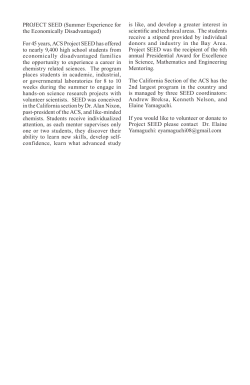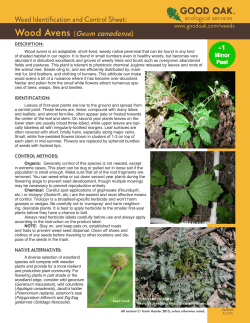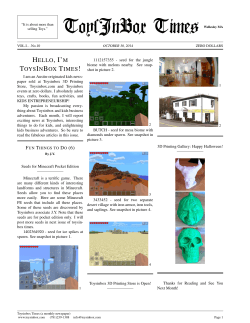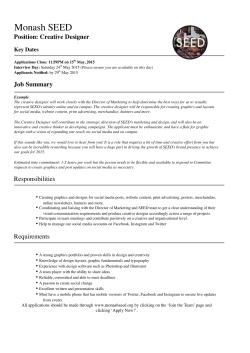
Implementation of a Colombian tropical high mountain conservation
IMPLEMENTATION OF A COLOMBIAN TROPICAL HIGH MOUNTAIN CONSERVATION SEED BANK: LIMITATIONS AND CHALLENGES Laura Victoria Pérez-Martínez, MSc - Bank Seed Leader - Bogotá Botanical Garden José Celestino Mutis 2015 National Native Seed Conference April 14th 2015 The World Bogotá on Terrain Bogotá Investigation and Conservation of Capital Natural Area’s Flora as an Strategy of Adaptation to Climate Change PLANT PROPAGATION BIOPROSPECTION SEED BANK • Conservation of plants out of its habitat • Prolong seed viability through dry and cold conditions • Physiological, genetic and phytosanitary quality • Relation cost-effectiveness • Complement of in situ conservation INSTITUTION Cardboard of Colombia Cenicafé Cenicaña International Center of tropical Agriculture (CIAT) Coltabaco CONIF Corporación Autónoma Regional de los Valles del Sinú y del San Jorge (CVS) Federación Nacional de Cacaoteros (Fedecacao) ICA-CORPOICA GROUPS BY SPECIES USE / TYPE Forestry Coffee Sugar cane Beans, yucca and tropical forages Tobacco Wood plants ORGANIZATION Private Private Private Private Private Private Forestry Public Cocoa Private Vegetables Mixed Secretaría de Agricultura del Valle Chontaduro SINCHI Amazonic UNIPALMA African Palm University of Antioquia Ornamentals Universitu of Caldas Fruits University of Córdoba Vegetables and yam University of Nariño Uchuva National University of Colombia - Seat Potatoes ans Andean Bogotá Tuberculus National University of Colombia – Seat Tropical fruits Medellín National University of Colombia – Seat Vegetables Palmira Universidad Pedagógica y Tecnológica Fruits, forestry and de Colombia (UPTC) ornamentals Public Public Privado Public Public Public Public Public Public Public Public Based on Valencia et al. 2010 Latitude Altitude Based on Ávila, 2014 Paramo • Absence of trees • Very high diversity (4926 spp) • Water reservoirs and births Particular climatic conditions: • Changes of radiation along the day • Changes of T° between day and night • Strong winds • UV Radiation • Low pressure of O2 Endemism more than 40% Changes in land use Climate Change Use of Paramo land for agriculture and cattle (mainly dairy herd) Main Objective Conserve the plant Biodiversity of High Elevation Mountain Forest, Paramo, and Agrobiodiversity of Capital Region Natural Areas. Conservation Investigation Source: www.businessetfree.com What are we doing? Implementation of a Prioritization Matrix Conservation Matrix Scarcity of knowledge is the bigger limitation Where are the species? - How is its phenological reproductive cycle? Can be storage the collected material? At what conditions? How is its germination process? In which conditions are the populations or seed source? How is its genetic variability? Puya trianae Implementation of a prioritization matrix So…What do we have? • Endemism • Distribution and populations (Bibliography+ Interviews + Herbariums) Floras of specific places Red Books Herbariums • Uses or phylogenetic relations • Taxonomic uniqueness • Conservation Status (Bibliography + Botanists) National Botanists! Botanical expeditions, and monitoring of populations Know Conserve Propagate How, When and Where to collect? How are they? Can they be storage? How propagate? Are they healthy? Population structure Morphology of fruits and seeds Behavior under storage Dormancy Fungi Adaptation to nurserys Bacteria Reproductive phenology Stages of maturity Ecological correlations Monitoring of viability Containers Comparison of 4° vs -20°C Quatily Virus First approaches - Looking for Seed Source of Paramo Representative Species How, Where and When to collect? Espeletia argentea 60 49.5 Six Species % Seeds with embryo 50 40 39.3258427 35.5 30 20 14.5 10 0 13/11/14 27/11/14 26/11/14 Cabañas San Francisco San Francisco Taquecitos Espeletia grandiflora 58 37.5 24.5 Chingaza 23 2 27/11/14 25/11/14 25/11/14 26/11/14 ChisacáLagunas 18/09/14 Mirador 22 1 26/11/14 Cabañas 24 02/09/2014 10 18/09/14 5 27/11/14 70 60 50 40 30 20 10 0 27/11/14 27/11/14 % semillas con embrión Different populations Chisacá- Vía Pasca Vía Pasca El Salero Jazmines San Calderitas Lagunas Francisco Sumapaz Pasquilla Verjones Curubital X2=113.91 p<0.001 120 35 100 30 80 25 MGT (days) Espeletia argentea Germination (%) First Approaches - Germination of Paramo Representative Species How to propagate? 60 40 20 15 10 20 5 0 Espeletia argentea Espeletia grandiflora Espeletia Espeletiopsis grandifl. Ec II corymbosa E. grandiflora Espeletia killipii 0 Espeletia argentea Espeletia grandiflora Espeletia Espeletiopsis grandifl. Ec II corymbosa 50 45 E. barclayana E. killipii Espeletiopsis corymbosa Germination (%) 40 35 30 25 20 15 10 5 13 species 0 Espeletia argentea Espeletia grandiflora Espeletia Espeletiopsis grandifl. Ec II corymbosa Espeletia killipii Espeletia killipii How to test viability? Chisacá Chingaza Ecotipo I 01/10/2013 20/12/2013-P2 20/11/2013-P2 30/12/2013 20/11/2013-P1 80 70 60 50 40 30 20 10 0 01/09/2013 Viaibility (%) Germination Method White hard, embryos Chisacá Ecotipo II Tune of Tetrazolium method by specie E. grandiflora 0.1% vs 1% 30° vs 40°C 3 h, 24 h, 48 h 13 spps tested 9 with good results Good coloured Low variation coefficient Morphology Reproductive ecology Relation of growth variables (age) with seed quality Espeletia argentea Volume of rosette E. grandiflora Height • Seeds of bigger plants from E. argentea and E. grandiflora were heavier. • Bigger plants of E. argentea had higher viability Prioritization Matrix Localities Selection of collection locations Protocol s Collect Health of the seeds Cleaning of seeds Low germination SIP Germination and TZ Test Genetic variability Morphological description of fruit and seeds Seed source Evaluation of embryo Locality, date, climate data Nursery RESEARCH (>__%*) Seed treatments Drying tests No Can be storage? Physiological maturity? No Yes Water content In vitro in vitro SIP Dry-until 3 % CH Weight equation (per specie or per population) How many seeds ? Entry in containers to 4°C and -20°C Monitoring Twice a year (every 6 months) 3 DATA BASES FOR SEED BANK MANAGEMENT New expeditions Test Testing of embryo Number of seed Repetitions 200 4 Germination 200 4 Tetrazolium* 150 3 Water content I 150 3 Water content II 150 3 Water content III 150 3 Monitoring for 3 years 1200 4 Phytosanity TOTAL 200 2400 The preceding presentation was delivered at the 2015 National Native Seed Conference Santa Fe, New Mexico April 13-16, 2015 This and additional presentations available at http://nativeseed.info
© Copyright 2025









